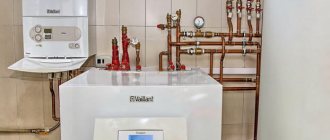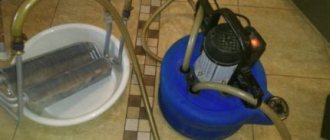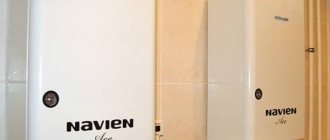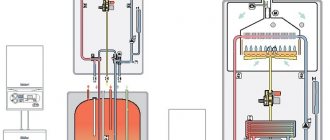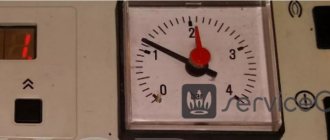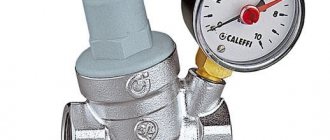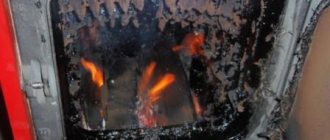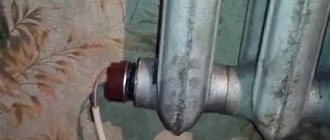When to do cleaning
There are 3 options for the development of events:
- Preventative cleaning of a gas boiler is done by the homeowner himself once every 2 years at the lowest cost.
- The procedure is carried out as the heat exchangers become contaminated with soot and scale, which reduces the efficiency of heating and water heating for domestic hot water needs. In this situation, you can still clean the boiler yourself, although calling a specialist is also possible.
- The heat generator stopped due to a breakdown, which often happens during the heating season. The fault is fixed by a called specialist, who also cleans the heat exchanger of soot.
In the photo, a master is servicing a condensing boiler with a closed cylindrical combustion chamber.
There is a heat exchange coil inside, which it is better not to touch yourself. The last 2 scenarios are clearly unattractive for the owners of the house, since they are associated with inconvenience and financial costs. You cannot do without a specialist even if a condensing boiler with a burner and a heat exchanger of a special design is used for heating. It is not recommended to climb there yourself, unless you are well versed in heating equipment of this kind.
Conclusion: preventive cleaning and flushing of the heat exchanger of a double-circuit gas boiler is performed quite quickly and does not require any expense, which is why it is the optimal solution.
How often should the boiler be cleaned?
The technical documentation for the boiler indicates how often it needs to be serviced. For closed circuits with the addition of reagents (single-circuit heating boilers), cleaning is required less frequently. It can be performed once every 2-3 years. The bithermic and secondary heat exchanger must be washed every year, and under difficult operating conditions (“poor” water composition) – twice a year.
Signs that the boiler urgently needs cleaning:
- the boiler slowly gains temperature;
- insufficient traction;
- the burner does not ignite or burns poorly;
- with the same gas consumption, the heat transfer is less;
- traces of soot or partially burnt paint in the area of the viewing window.
You should not neglect preventive measures, because this can result not only in broken equipment, but also a threat to the safety of all residents of the house. Clogged smoke exhaust ducts and pipes with build-up inside can cause serious accidents.
How to clean the heat exchanger of a floor-standing gas boiler
To disassemble a heating unit at home, you do not need any special tools; a regular set with screwdrivers, keys and pliers is sufficient. Preventive cleaning of the heat exchanger from soot and scale is carried out in the off-season, when the heating of the house is turned off. Having previously shut off the gas supply, we begin disassembling the boiler by removing the burner device in the following sequence:
- Disconnect all wires from the gas valve.
- Remove the thermocouple connected to the gas valve by a capillary tube from the combustion chamber.
- Disconnect the gas supply pipe.
- Unscrew the 4 nuts (or bolts) holding the stove with the burner. Pull the assembly out as shown in the photo:
The burner is removed along with the safety valve and mounting plate.
The gas boiler burner can be cleaned without further disassembly using an old toothbrush. The igniter, piezoelectric ignition device and flame control sensor (if equipped) should also be cleaned of soot. Now you need to get to the heat exchanger, for which you need to remove the top cover of the boiler, disconnect the draft sensor and the chimney pipe.
In the opened opening you will see insulation covering the chimney casing. Carefully remove the insulation, and then unscrew the screws securing the casing and remove it. Below it is a heat exchanger, from which you need to remove steel turbulators, as is done in the photo:
When removing the turbulators from the heat exchanger, the soot spills downwards, so the first thing to do is remove the burner
Cleaning the turbulators is easy; this can be done with a regular brush with metal bristles. But cleaning the heat exchanger of a floor-standing boiler is best done with the help of simple tools made by yourself according to the size of the smoke pipes. If they have a rectangular cross-section, then you need to bend a convenient flat spatula and a small scoop-shaped scraper from thin metal, then nail it to a wooden handle.
For round flame tubes, these same tools are made slightly curved. First, the walls of the pipes should be cleaned with a scoop, after which the soot remaining in the corners should be removed with a spatula.
At the end of the work, all surfaces of the heat exchanger can be cleaned with a brush screwed to a long handle. The last step is to remove soot from the bottom, where it was poured when cleaning the smoke pipes. This is what a clean heat exchanger of a heating unit looks like:
You can take a closer look at how to clean a gas boiler at home in the video:
Note. In the video presented by the master, the sequence of actions is broken. First he cleans the heat exchanger and then removes the burner, which is covered in soot. It is wrong to do this; first you need to remove the burner, and only then clean off the carbon deposits from the walls of the flame tubes.
Chemical flushing of a gas boiler
When chemically flushing a boiler, plaque and scale are removed from contaminated surfaces of boiler equipment and heat exchanger fragments, thanks to treatment with various chemical compounds and reagents. Most often, acid is used for washing boilers, which effectively removes carbonate scale, which is formed when magnesium and calcium salts and ferric iron combine and settle on the surface of the heat exchanger. Chemical washing is a standard, simple procedure that you can do yourself at some intervals. This flushing usually does not require disassembly of the structure.
Chemical cleaning of a gas boiler.
To carry out chemical flushing, you will need a chemical reagent and special equipment called a booster for flushing the heat exchanger. A booster is a device that consists of a tank for a cleaning agent, a pump and a heating element. During the procedure for flushing a gas boiler using a booster, a warm solution is first prepared and introduced into the heat exchange system (for acid flushing).
Thanks to the device, the cleaning reagent circulates and the waste liquid is removed. The acid chemical wash booster can be used on any type of gas boiler and is capable of effectively cleaning any type of boiler equipment. The main difference between a booster and installations that clean steam systems is that the booster does not need to use a heating element, since the cleaning liquid can be heated by the heat exchanger itself.
However, this is unsafe and not as effective, so it is recommended to use boosters that have heating elements, which allows you to use a solution of the same temperature and act on different parts of the heat exchanger with the same efficiency.
Gas boiler system diagram.
Acid washing is used to remove carbonate scale or ferric scale. The main reagents that are included in these solutions are sulfuric or hydrochloric acids; phosphoric or nitric acids are less commonly used. The reagent is selected depending on the type of contamination and the abundance of scale; the materials from which the heat exchanger and boiler are made are also taken into account.
Do-it-yourself flushing of a double-circuit gas boiler is carried out in two stages. At the first stage, an active reagent that has acidic properties is used. Using a reversible pump, it is necessary to create a powerful flow of solution, eroding the layer of deposits that would be affected by the acid.
The procedure takes from 2.5 to 6 hours, depending on how dirty the surfaces of the gas boiler are. When deposits and scale have dissolved, it is necessary to remove the active solution and fill the heat exchanger with a solution that neutralizes the acid residue. If the heat exchanger is made of cast iron, then due to the likelihood of the opposite effect, it is better not to flush the boiler with your own hands.
Cleaning soot from a wall-mounted heat generator
Getting to the main heat exchanger of most wall-mounted gas boilers is quite simple. The work algorithm is as follows:
- Turn off the gas supply by closing the appropriate tap.
- Remove the front panel of the unit.
- Unscrew and remove the front cover covering the combustion chamber.
To prevent the removed soot from pouring into the holes of the gas burner and you don’t have to think about how to remove the burner for cleaning, cover the nozzles with a sheet of thick paper or cardboard. After that, use an old toothbrush to clean the fins of the heat exchange unit from carbon deposits. If the stuck layer cannot be removed, you can use a brush with soft metal bristles.
When finished, sweep the inside of the unit with a brush and carefully remove the sheet of paper with soot. How to service a wall-mounted boiler is shown in detail in the video:
How to properly repair Navien gas boilers
Gas heating appliances are popular today among owners of apartments and private houses. It is functional, efficient, and work processes are fully automated.
Heaters from the Korean company Navien are leaders in this series. Components and electronics are manufactured in Korea and Japan, which guarantees their high reliability.
Navien wall-mounted boiler
The Navien gas boiler is equipped with a self-diagnosis and protection system, which simplifies maintenance and repair, and also increases operational safety. In the event of a serious malfunction, the automation will automatically turn off the boiler or warn the user about possible problems.
Features of Navien gas boilers
The Navien double-circuit gas heater stands out among a huge number of competitors for its compactness and attractive design.
Even if low-quality gas is used, subject to the requirements and recommendations of the manufacturer, the Navien gas boiler will please the owner with reliable and long-term performance of complex and expensive repairs.
The Navien gas boiler is capable of maintaining functionality with voltage drops of up to 30%, a drop in gas and water pressure in the supply lines. Navien boilers, regardless of type, are equipped with systems that guarantee uninterrupted operation under various operating conditions. The antifreeze system will prevent water from freezing during the cold season.
The control system is intuitive and can be adjusted remotely. The design uses steel heat exchangers, guaranteeing high efficiency and long service life.
The air pressure sensor used in the circuit ensures complete combustion of the fuel, which leads to lower costs. The water heating mode is activated simultaneously with the opening of the hot water tap. The burner automatically starts up, and when the tap is closed, the system goes into standby mode. The boiler heats water only for the heating system. The winter-summer mode automatically switches the system to DHW or vice versa.
Gas boiler design
The Navien boiler has a closed combustion chamber. The coaxial smoke removal system prevents combustion products from entering living spaces.
A wide range of temperature settings, both room and hot water, makes the Navien boiler competitive even with representatives from high price categories.
Types and advantages of Navien gas boilers
The Navien company supplies products in several series, differing primarily in the installation method:
- Floor-standing. This type is mostly used for installation in private homes, as it requires a separate room. The power of the units, produced in two series, varies from 11 to 60 kW.
- Wall-mounted. These are used everywhere due to their compactness, simplicity of design and unpretentiousness. These boilers are presented in five series with versions ranging from 10 to 40 kW.
The designs of Navien boilers are not much different. They are dual-circuit with a closed combustion chamber (except for the ATMO series). The only difference is in the electronics equipment, in terms of control.
The advantages of the equipment are as follows:
- Room temperature sensor and remote control, including on some models using a smartphone.
- Protection against power surges due to the installation of an innovative SMPS chip.
- Built-in frost protection system.
- Use of stainless steel heat exchangers.
The disadvantages of a gas heater, including a Navien boiler, include the need for uninterrupted power supply. The manufacturer recommends installing a UPS.
Internal structure of a gas boiler
Operation, diagnostics and repair
Installation, connection and first switching on are recommended to be carried out in the presence of representatives of gas services. Installation is carried out by certified specialists. Otherwise, repairs can cost a pretty penny.
You can perform the installation yourself, but only if you carefully follow the manufacturer's instructions. An important part of this work is the correct selection and installation of a smoke removal system.
Operations with the heater are described in detail in the instructions. Studying the positions is a fundamental factor in the flawless operation of the device.
Despite the highest reliability, like any other complex equipment, the Navien boiler requires repairs from time to time. It is recommended to contact the service.
Navien service centers offer a wide range of services, including the following types of work:
- Diagnostics followed by complete or partial replacement of units.
- Repair of units.
- Installation and post-warranty service.
- Cleaning radiators and pipes from scale and other deposits using special compounds.
- Replacement of consumables, gaskets and fastening elements.
Some “breakdowns” can be fixed independently.
To do this, you need to correctly recognize the cause of the malfunction and correctly assess your own knowledge and possible consequences. The built-in diagnostic system can help with this. The device displays codes - alphanumeric readings that indicate a particular failure.
Navien boiler remote control display
So code 01e means that the equipment has overheated. This can happen due to pump failure or clogged pipelines. In this case, check the condition of the pump impeller for integrity and jamming. They also check the resistance in the coil, that is, they determine whether there was a short circuit. It is recommended to determine whether there is airing. If so, the repair involves bleeding the air from the system.
Code 03e indicates an ignition problem. There are several reasons. This is a failure of the ionization sensor, a stop in the gas supply, or a break in the grounding circuit. The flame sensor is cleaned of dirt with a needle, and deposits on the electrode are removed with fine sandpaper.
There are about two dozen codes. The code table is attached to the instructions. If there is no code on the screen, but an unusual noise is heard, then this happens due to insufficient pipe capacity. Scale is formed due to poor quality coolant. It is drained and replaced with a new one.
The water heating temperature is also reduced. The boiler power may be too high for your system. Cleaning the heat exchanger is recommended. If it does not give results, the heat exchanger will have to be changed.
The reasons for failures are identified by things that are first checked independently. For example, clean the filter or assess the integrity of the wiring, the opening of valves, the presence of gas and water in the supply system, etc.
Strictly do not interfere with electronics, even if you have the appropriate education. This can only be done by specialists of a specific profile.
Heat exchanger
Do-it-yourself replacement of units
Some units and components are replaced or cleaned independently. It is recommended to order and purchase spare parts from Navien dealers.
Before opening the lid, it is recommended to disconnect the boiler from the water, gas and electricity supplies. Here are some examples of replacement.
To replace the fan, and it is only replaced as an assembly, you should:
- Disconnect the gas line.
- Remove the hose between the fan and the air sensor.
- Disconnect the connectors (there are two of them) connecting to the control unit.
- Unscrew the screws (3 pcs.) and pull out the fan. Next, install a new one and return everything to its previous state in the reverse order.
In the video you can see how to flush the Navien boiler:
If you change the main heat exchanger, then you need to do it as follows:
- First remove the following units - gas supply pipeline, ignition transformer, fan and overheating sensor.
- Then disconnect the grounding, unscrew the fastening screws and remove the combustion chamber.
- Next, unscrew the mounting screws (8 pcs.) and remove the flue gas collector.
- After this, unscrew the screws holding the combustion chamber cover (9 pcs.) and unscrew the screws connecting the heat exchanger to the combustion chamber body (6 pcs.)
- Pull out the heat exchanger and install a new one, performing the steps in reverse order.
If the heat exchanger is cleaned and there is no damage, then use the old one. But be sure to check the integrity of the ceramic seal. If necessary, it is changed.
kotlyhouse.ru
Rinsing and descaling
The procedure for removing scale from the internal heat exchange surfaces of gas boilers is performed in two ways: with and without removing the heat exchanger. If you intend to regularly clean and flush your heat generator, then it is more advisable to choose the second option. Each time disassembling the boiler to remove the heat exchanger is quite a troublesome task. Yes, and the designs of heaters are different, some need to be laid out almost by screws.
To wash the boiler without disassembling it, you will have to make a washing installation - a booster - with your own hands. It is a 15-20 liter container, filled with a washing solution, with connected hoses. Their ends are connected to the supply and return pipes of the heat generator and turn it on for heating. Circulation is provided by a separate pump, the same as in the heating system. It’s even better when the farm has a reversible pump to periodically change the direction of liquid flow.
In a booster for a bithermic heat exchanger, you should not use a water pump; it is better to find a circulation pump for heating
Advice. Place a mesh filter on the hose supplying the solution from the booster to the heating unit so that the scale does not circulate in a circle. It is possible that during washing it will have to be cleaned several times.
Before flushing the main heat exchanger of a gas boiler, you must perform the following operations:
- Reduce the pressure in the network to zero using a special valve (these are found in some boilers) or a Mayevsky tap on the nearest radiator;
- disconnect the heater from the system and empty it;
- check if your unit model has a built-in mud trap, remove and clean it.
A few words about how you can wash the heat exchanger of a gas boiler. The most popular folk remedy, safe for all elements of the heat generator, is a solution of citric acid and vinegar. According to reviews from users of a well-known forum, 9% vinegar or citric acid, dissolved at the rate of 20 g per 1 liter of water, works well. If necessary, the concentration can be increased.
In addition, there are many commercial products available for sale intended for chemical cleaning of heat exchangers (for example, Antiscale). The washing time is indicated on the product packaging, and when working with citric acid, the duration of the process depends on the degree of contamination and can take from 1 to 3 hours.
Advice. If a reversible pump is not available, then during operation periodically swap the hoses, starting the fluid flow in the opposite direction. If there is reverse flow, the heating must be turned off.
After finishing washing, fill the container with ordinary purified water and rinse the unit from chemicals and remaining dirt, and clean the mud trap again.
Common Mistakes
Navien equipment has excellent build quality, but any equipment can fail. For convenience, each fault has its own special code, which is displayed on the device screen. Error classification:
- E01. Overheating of the device due to an increase in temperature level.
- E02. There is too little fuel in the system, and the device circuit may also break.
- E03. No flame alert.
- E04. Incorrect signal about the presence of fire or a short circuit in the sensor circuit.
- E05. The circuit in the water temperature indicator is broken.
- E06. A short circuit has occurred in the temperature sensor.
- E07. Circuit breakage in the water temperature sensor.
See also: decoding and eliminating errors 03, 09 and 27 on the Navien boiler.
Frequent errors on a Navien gas boiler:
- E08. Circuit failure in the hot water temperature sensor.
- E09. Problems with the fan.
- E10. Difficulty removing smoke.
- E12. The fire went out during operation.
- E13. Short circuit in the flow indicator.
- E14. No gas supply.
- E15. Damage to the control board.
- E16. Device overheating.
- E17. DIP switch malfunction.
- E18. Smoke exhaust sensor overheating.
- E27. Problems with the air pressure sensor.
When no error codes appear on the display, but the device hums or makes noise, it means that scale has formed, which prevents water from passing normally through the pipes.
If water does not flow, the 3-way valve must be replaced.
Gas boiler Navien Ace 35k error 02:
Troubleshooting
In many cases, you can repair the Navien mounted boiler yourself, for example, when code 02 appears on the control display. This problem is one of the most common. List of what to do in case of error 02 on the Navien boiler:
- Bleed the equipment.
- Measure the pressure level.
- Make sure there is no short circuit.
- See what position the distribution valve is in. If it is closed, you need to open it. Oddly enough, this very banal problem happens quite often.
- Clear the sensor flag.
Code 03 is most often triggered if the flame sensor is dirty. It should be cleaned with fine-grained sandpaper. In case of problem 05, it is necessary to diagnose the condition of the circuit between the controller and the sensor. In case of serious damage, the sensor should be replaced.
Navien boiler error 03:
When error 09 appears on the Navien boiler, it means a fan failure. If the code is displayed, but this part is intact and in good working order, you need to check the condition of the control board. This may require calling a specialist, but with certain knowledge you can carry out this procedure yourself.
A similar malfunction is error 10 on the Navien gas boiler. To fix it, you need to check the condition of the fan and, if necessary, replace this part. In addition, it may be necessary to check the contacts in the pipes of the measuring device and clean the chimney.
If error 13 on the Navien boiler, you need to change the sensor. Sometimes the operating noise of equipment may disappear after washing the equipment, but this method does not always work. To drain, you need to open the taps as much as possible and reduce the fuel temperature.
Disassembling the Navien boiler and cleaning the heat exchanger:
Code 18 indicates that the temperature sensor in the smoke system has overheated. You should check the quality of passage in the chimney, as well as the connecting circuits and the sensor itself. You need to make sure that there is no backdraft. In addition, the control board may fail, but such situations occur extremely rarely.
Another error with code 27 indicates a breakdown of the air pressure sensor. The condition of all connecting wires should be checked. In case of serious problems, the sensor must be replaced.
How to flush the heat exchanger of a double-circuit boiler
The method for removing scale from the DHW tract depends on the type of heat exchanger installed in your heat generator. There are only two of them:
- bithermal, it combines heating of the coolant and water for hot water supply;
- secondary heater made of stainless steel.
It is better to clean units with a bithermic heater using a booster, since removing such a unit can be quite difficult. Hoses leading from the tank are connected instead of cold water supply and hot water outlet, after which the circulation pump and the boiler itself start. The heating temperature should be limited to 50-55 degrees.
If a double-circuit boiler has a secondary heat exchanger, in most cases it can be removed. Unscrew the front panel, release the control unit and move it to the side. The plate heater for DHW is located at the bottom of the gas boiler and is secured with 2 bolts. Unscrew them, disconnect the pipes and remove the heat exchanger. Next, immerse it in a pan with a solution of citric acid and boil on the stove, which is described in detail in the video:
Cleaning methods
How to flush the heat exchanger of a double-circuit boiler at home? In some cases, disassembling the unit is required, while in others you can do without it. The purpose of dismantling is to provide access to the heating element. When cleaning and disassembling, you can get by with minimal costs, but this option is time-consuming and labor-intensive.
Sometimes partial disassembly is performed - for example, to clean the fire-tube heat exchanger of a floor-standing boiler from soot. The heat exchanger itself cannot be dismantled at home; access to it is freed up by removing the burner and the cover with the chimney outlet pipe.
How to remove a heat exchanger from a wall-mounted gas boiler? First, turn off the power to the electrical unit, turn off the water supply, and drain water from both circuits and the expansion tank. After this, the heat exchanger is dismantled.
How to clean the heat exchanger of a gas boiler from scale with your own hands? If there is a small amount of plaque inside, you can get by with manual washing using a citric acid solution.
If there is a thick layer of scale, you will need a washing unit that will circulate the detergent for several hours. A 10-liter tank with a pump is suitable for this purpose (you can use a circulation pump from the circuit). Two hoses from the pump are connected to two heat exchanger pipes.
There are three cleaning methods:
In the first case, you can use a brush, scraper, or vacuum cleaner to remove plaque. Heat exchanger parts are pre-soaked in cleaning solutions.
During chemical treatment, an acid wash solution is pumped into the system using a booster and driven through a heat exchanger for several hours. Acidic solutions are good at removing ferrous and carbonate sediment. At the end of cleaning, the product is drained and a neutralizing agent is added.
The hydrodynamic method is the injection of water with abrasives into the system under pressure. In this way, the internal surfaces are cleaned mechanically, but the cleaning efficiency is higher than when processed manually. Flushing can be done without dismantling the system, but it is quite expensive. When cleaning yourself, you need to monitor the pressure in the circuits to avoid rupture of the heat exchanger.
